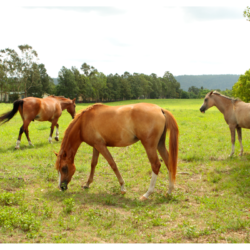Equine Metabolic Syndrome (EMS) is an increasingly common condition in recreational and sport horses, characterised by obesity, insulin resistance and repeated episodes of laminitis. Understanding the causes, symptoms, diagnostic methods and treatments of this disease is essential for owners and vets to ensure the well-being of equines. In this article, we will explore every aspect of EMS in detail to provide a comprehensive and useful resource.
What causes the disease?
Equine Metabolic Syndrome (EMS) is classically characterised by repeated episodes of laminitis in an obese horse. In older horses, this condition is often associated with Cushing’s syndrome. Obesity is a major risk factor for EMS, and is becoming increasingly common in both leisure and sport horses. This syndrome results from a disturbance in insulin production and abnormal fat distribution.
Insulin is a hormone secreted by the pancreas, allowing glucose to enter the cells. In horses with MHE,insulin has no effect on the receptors in the cells, leading to an accumulation of glucose in the blood. Some breeds, such as ponies, saddle horses, Purebred Spanish, miniature horses, Morgans and Thoroughbred Arabians, are genetically predisposed, although the genes responsible are not known.
Horses suffering from Cushing’s syndrome are also at greater risk, as this disease promotes a disturbance in insulin production. In addition, an over-energetic diet rich in carbohydrates and a lack of exercise are significant risk factors. The origins of this condition are therefore multiple, including genetic predisposition and environmental factors.
What are the symptoms of EMS?
Horses with equine metabolic syndrome (EMS ) are often obese or have an abnormal distribution of fat. Fat deposits can be seen under the skin, particularly in the bun, shoulders, girth, base of tail, saltboxes and sheaths in males and udders in mares. Even with proper management of diet and exercise, these horses tend to remain overweight.
Another key symptom of EMS is chronic or acute laminitis. Signs may be subtle, but prominent hoof growth rings and a convex sole are indicators of chronic laminitis. Horses with Cushing’s syndrome also often show signs of laminitis. Older horses with compatible symptoms should be systematically checked for the presence of both diseases.
EMS can also affect reproduction. Overweight mares may have difficulty suckling their foals because of excess fatty tissue in the udder, making the teats less accessible. Obesity and EMS can lead to a longer ovulatory season, longer periods between heats and reduced fertility. Clinical signs such as reduced fertility, localised or generalised fat deposits and signs of chronic laminitis are common.
It is important not to confuse EMS with Cushing’s syndrome. Although there are similarities between the two conditions, hirsutism is a distinct symptom of Cushing’s syndrome and is not present in horses with EMS.
How is the diagnosis made?
Diagnosis of equine metabolic syndrome (EMS) is based on observation of clinical signs and specific blood tests. Repeated episodes of laminitis and obesity are warning signs, prompting the vet to suggest tests to confirm the diagnosis of EMS. Regular clinical monitoring is recommended, particularly for breeds at risk.
To diagnose EMS, insulin is measured in the blood, although this test lacks sensitivity. If the result is negative, a dynamic test is preferred. There are two types of dynamic test:
- insulin and glucose levels are compared before and after the administration of a sweet food,
- or glucose levels are compared before and after an insulin injection.
For horses over 10 years of age or showing signs consistent with Cushing’s syndrome, it is essential to test for the disease as well. Clinical signs and changes in blood parameters, such as obesity with abnormal fat deposits, laminitis, hyperglycaemia and hyperinsulinaemia, are likely indicators of EMS.
If in doubt, a glucose tolerance test can be carried out. This involves monitoring blood glucose levels and measuring insulin levels before and after a fasting glucose infusion. In a normal horse, blood glucose levels rise and then fall back to normal values one or two hours later. On the other hand, in a horse with MHE, blood glucose levels remain high for several hours after glucose administration.
What treatments are available?
Treatment of equine metabolic syndrome (EMS) focuses mainly on managing the diet and increasing physical exercise. Horses with EMS should be fed a low-carbohydrate diet. In the case of obesity, energy intake should also be limited.
Restricting access to pasture is crucial, as grass, particularly in spring and autumn, is often too rich in soluble carbohydrates. Owners should avoid concentrates made from cereals, molasses and beetroot, which are rich in soluble carbohydrates. Instead, they should feed low-energy, fibrous hay. If the horse is in normal body condition, they can increase the fat intake to maintain the calorie level of the ration.
Vets strongly recommend exercise for horses with MHE, except in the case of locomotor problems linked to laminitis. Exercise increases energy expenditure and promotes weight loss, improving the horse’s sensitivity to insulin. For horses that have been resting for a long time, it is important to resume exercise very gradually.
Medicinal treatment may include levothyroxine to promote weight loss in acute laminitis or metformin for persistent hyperinsulinaemia. In cases of associated Cushing’s syndrome, daily administration of pergolide is recommended. Regular monitoring of the horse’s body condition and insulin levels is essential to assess response to treatment.
What are the natural alternatives?
Certain medicinal plants offer solutions for the treatment of equine metabolic syndrome (EMS). Chaste tree ( Vitex agnus-castus), fenugreek (Trigonella foenum-gracum), olive tree (Olea europaea), Asian ginseng (Panax ginseng) and ginger (Zingiber officinale) all have significant beneficial effects.
Turmeric is renowned for its anti-obesity, antioxidant, antibiotic, anti-inflammatory, digestive and analgesic properties. It helps prevent type 2 diabetes and reduces inflammation. It also treats digestive disorders and relieves inflammatory diseases.Nettle has astringent, haemostatic and diuretic properties. It also helps to lower blood sugar levels, stimulate liver and kidney functions, and eliminate toxins.
Dandelion is used to improve liver, biliary and urinary functions, reduce water retention and relieve constipation. Bilberry has anti-diabetic, antioxidant, astringent and vasoprotective properties. It also helps to lower blood sugar levels and protect against insulin resistance.
Siberian ginseng is cholesterol-lowering, adaptogenic, antioxidant, immunostimulant and anti-inflammatory, and regulates blood sugar levels while protecting the liver. Plants such as burdock, milk thistle, rosehip and spirulina offer additional benefits. For example, they help eliminate toxins, support the immune system and improve microcirculation.
These natural alternatives can be combined with an overall EMS treatment. However, they are not a substitute for the necessary hygienic and medicinal interventions. They can, however, enhance the effectiveness of treatments and offer additional support.





